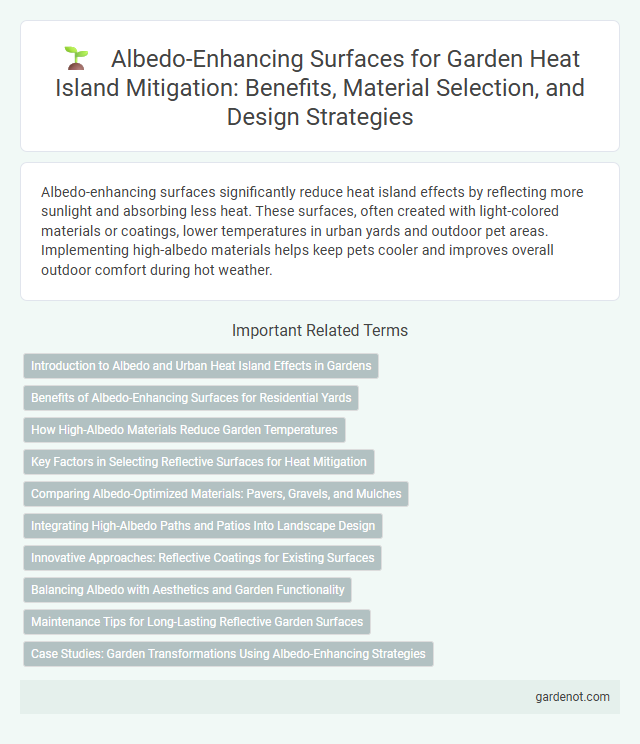Albedo-enhancing surfaces significantly reduce heat island effects by reflecting more sunlight and absorbing less heat. These surfaces, often created with light-colored materials or coatings, lower temperatures in urban yards and outdoor pet areas. Implementing high-albedo materials helps keep pets cooler and improves overall outdoor comfort during hot weather.
Introduction to Albedo and Urban Heat Island Effects in Gardens
Albedo-enhancing surfaces increase the reflectivity of garden areas, reducing heat absorption and mitigating urban heat island effects. High albedo materials reflect more solar radiation, lowering surface temperatures and improving microclimate conditions in urban yards. This approach helps maintain cooler garden environments, promoting plant health and reducing overall energy consumption in heated urban spaces.
Benefits of Albedo-Enhancing Surfaces for Residential Yards
Albedo-enhancing surfaces in residential yards significantly reduce local temperatures by reflecting more solar radiation, which helps mitigate urban heat island effects and lowers cooling energy demand. These surfaces improve outdoor comfort, decrease heat-related health risks, and contribute to energy savings by minimizing the reliance on air conditioning. Incorporating materials with high reflectivity, such as light-colored pavements or reflective coatings, supports sustainable yard design and enhances overall neighborhood resilience to heat stress.
How High-Albedo Materials Reduce Garden Temperatures
High-albedo materials reflect a significant portion of solar radiation, reducing heat absorption in garden surfaces and lowering overall temperatures. These reflective surfaces can decrease localized heat by up to 10degF, mitigating the urban heat island effect within yard environments. Implementing light-colored pavements, rocks, and coatings enhances albedo, promoting cooler microclimates and healthier plant growth.
Key Factors in Selecting Reflective Surfaces for Heat Mitigation
Selecting reflective surfaces for heat island mitigation requires careful evaluation of albedo, thermal emittance, and durability under local climate conditions. High-albedo materials with sustained reflectivity reduce surface temperatures effectively and minimize heat absorption. Surface texture and maintenance frequency play crucial roles in preserving reflectivity and long-term performance in urban yards.
Comparing Albedo-Optimized Materials: Pavers, Gravels, and Mulches
Albedo-optimized materials such as pavers, gravels, and mulches significantly influence heat island mitigation by reflecting more solar radiation and reducing surface temperatures. Pavers with high solar reflectance provide durable, stable surfaces with consistent albedo performance, while gravels offer porous, reflective coverage that improves groundwater infiltration and heat dissipation. Mulches vary in albedo based on color and composition, with light-colored options enhancing reflectivity but requiring regular maintenance to maintain effectiveness in reducing urban heat accumulation.
Integrating High-Albedo Paths and Patios Into Landscape Design
Integrating high-albedo paths and patios into landscape design significantly reduces urban heat island effects by reflecting more solar radiation and lowering surface temperatures. Materials such as light-colored concrete, pavers, and reflective aggregates enhance albedo, contributing to cooler microclimates in residential and commercial yards. Strategic placement of these high-albedo surfaces around vegetation optimizes thermal comfort while preserving green space functionality.
Innovative Approaches: Reflective Coatings for Existing Surfaces
Reflective coatings for existing surfaces significantly reduce urban heat island effects by increasing the albedo of pavements and rooftops, reflecting more solar radiation back into the atmosphere. Advanced materials such as cool roof coatings and high-reflectivity paints incorporate nanotechnology to enhance durability and heat reflectance, thereby lowering surface temperatures by up to 30%. Implementing these innovative approaches in urban heat island mitigation yards optimizes thermal comfort and reduces cooling energy consumption in surrounding buildings.
Balancing Albedo with Aesthetics and Garden Functionality
Albedo-enhancing surfaces in heat island mitigation yards increase solar reflectance to reduce localized temperatures while maintaining visual appeal and garden functionality. Selecting materials with moderate reflectance levels balances thermal benefits and aesthetics, ensuring plant health and outdoor usability. Incorporating textured or colored reflective surfaces helps integrate climate control without compromising garden design integrity.
Maintenance Tips for Long-Lasting Reflective Garden Surfaces
Regularly clean albedo-enhancing surfaces using gentle water sprays to remove dust and debris that reduce reflectivity. Inspect for cracks or wear and promptly repair with compatible reflective coatings to maintain optimal surface performance. Avoid harsh chemicals or abrasive tools that can degrade the reflective layer, ensuring long-lasting heat island mitigation benefits.
Case Studies: Garden Transformations Using Albedo-Enhancing Strategies
Case studies of garden transformations using albedo-enhancing strategies demonstrate significant reductions in local temperatures by increasing surface reflectivity. High-albedo materials such as white gravel, reflective mulches, and light-colored paving reduce heat absorption and contribute to cooler microclimates in urban yards. These interventions have been proven to mitigate heat island effects, improve plant health, and decrease energy consumption for nearby buildings.
Albedo-enhancing surface Infographic

 gardenot.com
gardenot.com